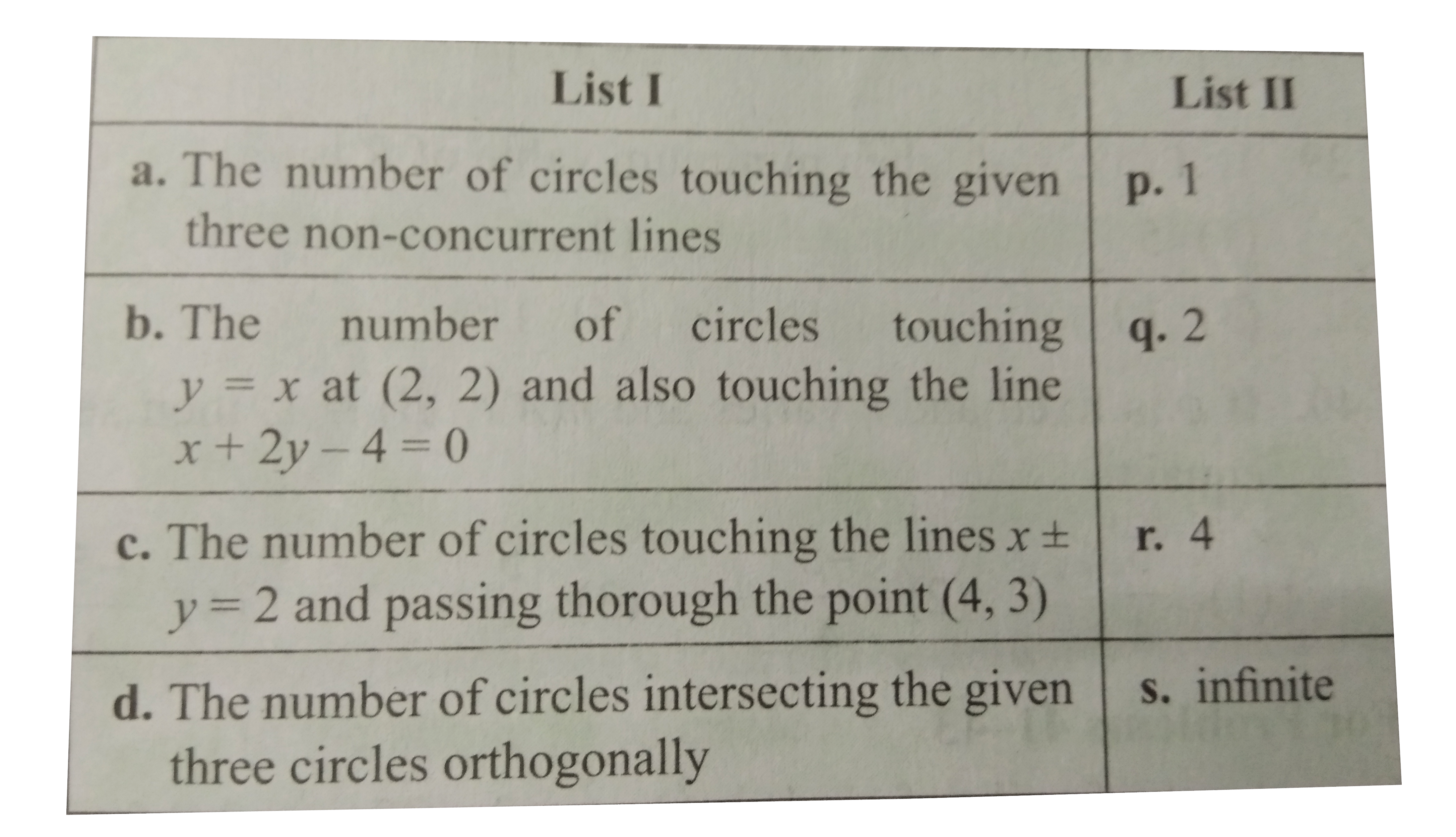If the coefficients of rth and (r+1)th terms in the expansion of (3+7x)29 are equal, then r equals a. 15 b. 21 c. 14 d. none of these
15
21
14
none of these
The correct Answer is:B
To solve the problem, we need to find the value of r such that the coefficients of the r-th and (r+1)-th terms in the expansion of (3+7x)29 are equal.
1. Understanding the Binomial Expansion:
The binomial expansion of (a+b)n is given by:
Tk=(nk−1)an−(k−1)bk−1
where Tk is the k-th term, n is the power, a and b are the terms in the binomial.
2. Identifying the Terms:
For our case, a=3, b=7x, and n=29.
- The r-th term Tr is given by:
Tr=(29r−1)⋅329−(r−1)⋅(7x)r−1
- The (r+1)-th term Tr+1 is given by:
Tr+1=(29r)⋅329−r⋅(7x)r
3. Extracting the Coefficients:
- Coefficient of Tr:
Cr=(29r−1)⋅330−r⋅7r−1
- Coefficient of Tr+1:
Cr+1=(29r)⋅329−r⋅7r
4. Setting the Coefficients Equal:
Since the coefficients are equal:
(29r−1)⋅330−r⋅7r−1=(29r)⋅329−r⋅7r
5. Simplifying the Equation:
Dividing both sides by 329−r and 7r−1:
(29r−1)⋅3=(29r)⋅7
6. Using the Property of Binomial Coefficients:
We know that:
(29r)=29!r!(29−r)!and(29r−1)=29!(r−1)!(30−r)!
Thus, substituting these into the equation gives:
29!(r−1)!(30−r)!⋅3=29!r!(29−r)!⋅7
7. Cancelling Factorials:
Cancelling 29! from both sides:
3(30−r)=7r
8. Cross Multiplying:
Cross multiplying gives:
3r=7(30−r)
Expanding this:
3r=210−7r
9. Solving for r:
Combining like terms:
3r+7r=210⟹10r=210⟹r=21010=21
Conclusion:
Thus, the value of r is 21.
The binomial expansion of (a+b)n is given by:
Tk=(nk−1)an−(k−1)bk−1
where Tk is the k-th term, n is the power, a and b are the terms in the binomial.
For our case, a=3, b=7x, and n=29.
- The r-th term Tr is given by:
Tr=(29r−1)⋅329−(r−1)⋅(7x)r−1
- The (r+1)-th term Tr+1 is given by:
Tr+1=(29r)⋅329−r⋅(7x)r
- Coefficient of Tr:
Cr=(29r−1)⋅330−r⋅7r−1
- Coefficient of Tr+1:
Cr+1=(29r)⋅329−r⋅7r
Since the coefficients are equal:
(29r−1)⋅330−r⋅7r−1=(29r)⋅329−r⋅7r
Dividing both sides by 329−r and 7r−1:
(29r−1)⋅3=(29r)⋅7
We know that:
(29r)=29!r!(29−r)!and(29r−1)=29!(r−1)!(30−r)!
Thus, substituting these into the equation gives:
29!(r−1)!(30−r)!⋅3=29!r!(29−r)!⋅7
Cancelling 29! from both sides:
3(30−r)=7r
Cross multiplying gives:
3r=7(30−r)
Expanding this:
3r=210−7r
Combining like terms:
3r+7r=210⟹10r=210⟹r=21010=21
Thus, the value of r is 21.
Topper's Solved these Questions
- BINOMIAL THEOREMBOOK - CENGAGE ENGLISHCHAPTER - BINOMIAL THEOREMEXERCISE - Multiple Correct Answer Type
27 Videos
- BINOMIAL THEOREMBOOK - CENGAGE ENGLISHCHAPTER - BINOMIAL THEOREMEXERCISE - Linked Comphrension
20 Videos
- BINOMIAL THEOREMBOOK - CENGAGE ENGLISHCHAPTER - BINOMIAL THEOREMEXERCISE - Concept Application Exercise 8.8
10 Videos
- AREABOOK - CENGAGE ENGLISHCHAPTER - AREAEXERCISE - Comprehension Type
2 Videos
- CIRCLE BOOK - CENGAGE ENGLISHCHAPTER - CIRCLE EXERCISE - MATRIX MATCH TYPE
7 Videos
Similar Questions
The value of x in the expression (x+x(log)10x)5 if third term in the expansion is 10,00,000 is/are
a. 10 b. 100 c. 10−5/2 d. 10−3/2
View SolutionThe sixth term in the expansion of (√2log(10−3x)+(2(x−2)log3)15)m is equal to 21, if it is known that the binomial coefficient of the 2nd 3rd and 4th terms in the expansion represent, respectively, the first, third and fifth terms of an A.P. (the symbol log stands for logarithm to the base 10) The value of m is
View SolutionIf the third term in the expansion of (1+x)mis−18x2, then find the value of m.
View SolutionIn the following figure, the graphs of two functions y = f(x) and y = sin x are givne. They intersect at origin, A(a,f(a)),B(π,0)andC(2π,0).Ai(i=1,2,3) is the area bounded by the curves as shown in the figure, respectively, for x∈(0,a),x∈(a,π),x∈(π,2π).
If A1=1+(a−1)cosa−sin a, then

The function f(x) is
View SolutionMatch the following lists.

View SolutionIf the rth term in the expansion of (1+x)^(20) has its coefficient equal to that of the (r+ 4) th term,find r
View SolutionIf the coefficient of rth term and (r+1)th term in the expansion of (1+x)20 are in ratio 1:2, then r is equal to
View SolutionIf the coefficients of rth and (r+1)th terms in the expansion of (3+7x)29 are equal , then r is equal to
View SolutionIf the coefficients of (r−5)th and (2r−1)thterms of the expansion (1+x)34 are equal, find r.
View SolutionIf the coefficients of (r−5)thand(2r−1)th terms in the expansion of (1+x)34 are equal, find r.
View SolutionIf the coefficients of the rth, (r+1)th,(r+2)th terms is the expansion of (1+x)14 are in A.P, then the largest value of r is.
View SolutionIf the coefficients of rth and (r+1)th terms in the expansion of (3+7x)29 are equal, then r is equals to a. 15 b. 21 c. 14 d. none of these
View SolutionIf the coefficients of rth, (r+1)th,and(r+2)th terms in the expansion of (1+x)14 are in A.P., then r is/are a. 5 b. 11 c. 10 d. 9
View SolutionIf the rth term in the expansion of (1+x)20 has its coefficient equal to that of the (r+ 4)th term, find r
View SolutionIf the coefficients of the (n+1)th term and the (n+3)th term in the expansion of (1+x)20 are equal , then the value of n is a. 10 b. 8 c. 9 d. none of these
View SolutionIf the coefficients of rth term and (r+4) th term the expansion of (1+x)34 are equal then the value of r is
(i) 15
(ii) 17
(iii) 16
(iv) None of these
View Solution

